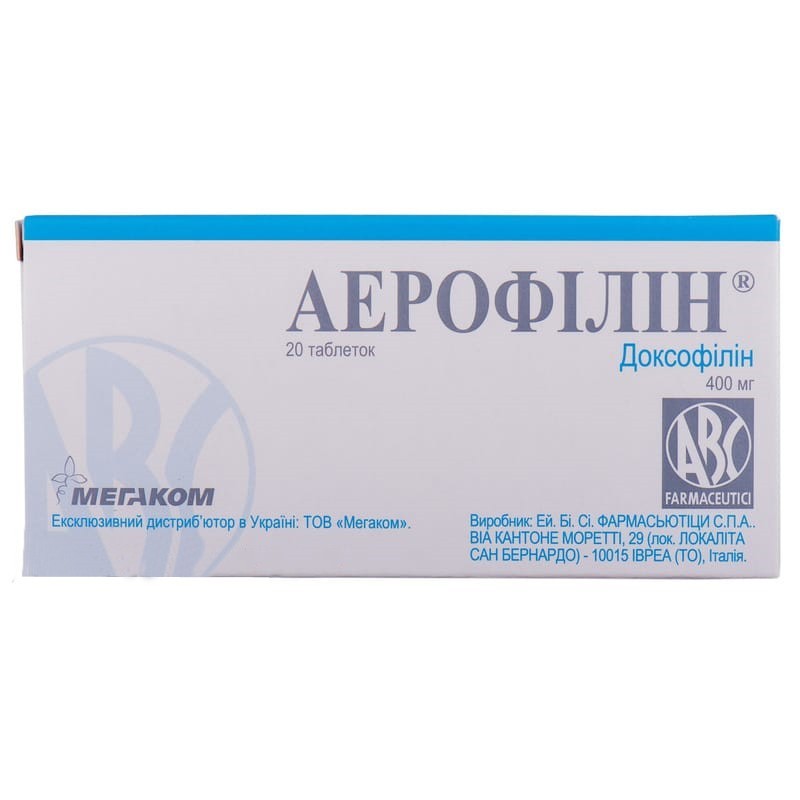



 Secure and encrypted payment processing
Secure and encrypted payment processing We ship to over 40 countries including the USA, UK, Europe, Australia and Japan
We ship to over 40 countries including the USA, UK, Europe, Australia and Japan Guaranteed refund or reship if you haven't received your order
Guaranteed refund or reship if you haven't received your orderDoxofylline acts exclusively on the smooth muscles of the pulmonary vessels and bronchi, causing bronchodilation. this is due to the ability to inhibit the PDE enzyme, which is accompanied by an increase in the intracellular content of cAMP. cAMP accumulation in the cells inhibits the connection of myosin with actin, which reduces the contractile activity of smooth muscles and contributes, in particular, to relaxation of the muscles of the bronchi and elimination of bronchospasm. unlike other methylxanthines, Doxofylline does not block adenosine receptors and does not affect the transport of calcium ions. Thus, the drug does not have a stimulating effect on the central nervous system and does not affect the functioning of the heart, blood vessels, and kidneys.
Pharmacokinetics T½ Doxofylline is 6 hours, so it is allowed to use the drug 3 times a day, which ensures a constant and effective concentration of the drug in blood plasma. After oral administration of the drug in the form of tablets Cmax in blood plasma is reached after 60 minutes. The absolute oral bioavailability is about 62.6%; at a pH of 7.4, the amount of drug that binds to plasma proteins is about 48%.
With oral administration, 4% of Doxofylline is excreted unchanged in the urine.
BA, lung disease with a bronchial spastic component (hobl).
The doctor sets the dose of the drug individually, depending on the age, body weight and characteristics of the patients metabolism. the average daily dose for adults and children over the age of 12 years is 800–1200 mg (1 tablet 2-3 times a day). children aged 6-12 years are prescribed ½ tablets 2-3 times a day (12-18 mg / kg of body weight per day).
Hypersensitivity to Doxofylline or other components of the drug, as well as other xanthine derivatives, acute myocardial infarction, arterial hypotension.
From the digestive tract: nausea, vomiting, pain in the epigastric region, gastroesophageal reflux, diarrhea, dyspepsia are rarely possible.
From the nervous system: irritability, headache, insomnia, dizziness, tremor.
From the cardiovascular system: extrasystole, palpitations.
From the respiratory system: tachypnea.
On the part of the blood system: in isolated cases - hyperglycemia, albuminuria.
Allergic reactions: anaphylactic shock (angioedema) is rarely possible.
With caution, the drug should be used to treat patients with cardiopathy, ag, elderly people and patients with severe hypoxia, hyperthyroidism, chronic right ventricular failure, congestive heart failure, liver and kidney diseases, peptic ulcer, as well as high body temperature, cardiac arrhythmias alcoholism. special care should be taken in the treatment of patients with chronic heart failure, since they have reduced excretion of the drug from the blood, which lasts for a long period, even after the end of treatment.
If there are factors affecting the excretion of xanthine derivatives, it is recommended to monitor the concentration of the drug in the blood to control therapy.
The drug contains lactose, therefore, in patients with rare hereditary forms of galactose intolerance, lactase deficiency or glucose-galactose malabsorption syndrome, it should not be used.
During pregnancy and breastfeeding. Due to the limited experience with the drug during pregnancy, Doxofylline can only be prescribed taking into account the ratio of benefit to the mother / risk to the fetus. Doxofylline is contraindicated during lactation.
Children. The drug is used in children over the age of 6 years.
The ability to influence the reaction rate when driving vehicles and working with other mechanisms. Does not affect.
Limit the use of foods and drinks containing caffeine. should not be used simultaneously with other preparations containing xanthines. care must be taken with the combined use of aerofillin and sympathomimetics. the simultaneous use of drugs such as erythromycin, troleandomycin, lincomycin, clindamycin, allopurinol, cimetidine, influenza vaccine, propranolol, as well as the interaction of xanthines with disulfiram, fluvoxamine, interferon alfa, oral contraceptives may slow down the withdrawal of derivatives, while plasma drug level. in such cases, the dose of the drug should be reduced.
With the use of phenytoin, other anticonvulsants, and smoking, as well as with the interaction of xanthines with rifampicin, ritonavir, sulfinpyrazone, the elimination of xanthine derivatives can be accelerated, while T½ decreases. In these cases, the dose of the drug should be increased.
Xanthines have toxic synergism with ephedrine, halotane or ketamine, and it can also counteract the effects of adenosine and other neuromuscular blockers.
The elimination of lithium may increase with a subsequent decrease in the severity of the effect.
Xanthines may increase hypokalemia caused by hypoxia or associated with the use of β stimulants2-adrenoreceptors (β agonists2-adrenoreceptors), corticosteroids and diuretic drugs.
Given the pharmacological reasons, the simultaneous use of xanthines and β-adrenergic blockers should be avoided, since the latter lead to bronchospasm.
Symptoms: cardiac arrhythmias, convulsions (tonic, clonic), agitation, increased diuresis, increased severity of manifestations of side effects.
Treatment: since there is no specific antidote, in case of an overdose, symptomatic therapy of heart failure and anticonvulsant therapy are performed. After the disappearance of signs of intoxication, the use of the drug can be resumed.
At a temperature not exceeding 25 ° C.